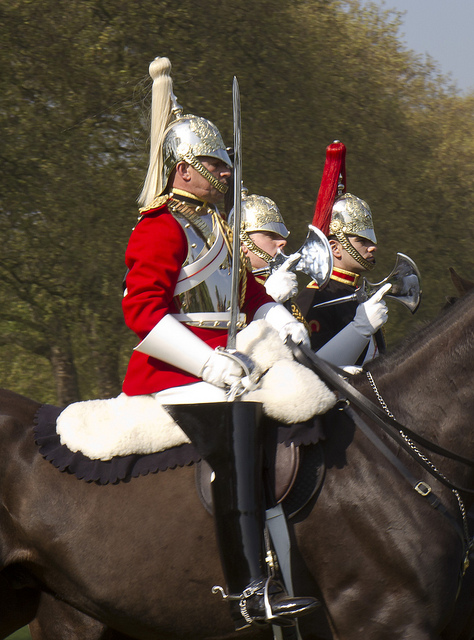[VIDEOSINGLE type=”youtube” keyid=”2Kq0pUrNjdc”, width=”560″, height=”344″]&
I know I wasn’t the only one who sat up straight and spilled coffee early this morning while watching the Royal Wedding. I was squinting to see if I might catch a glimpse of one of the Household Cavalry’s farriers escorting the carriages–the farrier alone usually has a black plume in his helmet and he carries a huge shiny ax.
But instead I saw a riderless horse bolt from the back of the pack. Had I suddenly been fast-forwarded to the Kentucky Derby? Was this horse going for the course record? But there was no Calvin Borel perched on its back. The saddle was empty.
Thinking back, I’m surprised that Princess Anne didn’t stick her hand out of a carriage or limo and just grab the reins.
CNN was using amazing telephoto lenses, which foreshorten the distance. It had been a little unsettling to watch. I know that Kate Middleton is allergic to horses, and it looked like the Household Cavalry mounts were hanging their heads right in the magnificent 1902 State Landau…but I judged that be to be a function of the lens distortion.
When the riderless horse bolted, it was clear that he came right up almost beside Kate and William before veering off.
According to multiple press sources online, the horse amazingly found his own way back to the Hyde Park Barracks where he’s stabled. Neither the horse nor the rider was injured.

It sounds like the horse simply slipped on the pavement and went down and his rider had to bail or was ejected from the saddle. That’s not simple with all that gear and those huge boots on. He or she and the horse could have easily been tangled up, so it’s wonderful that horse and rider were clear of one another and, apparently, everyone else.
I’ve been following the Household Cavalry quite closely and only in the past few days really thought about the fact that this could happen. What made me think of it was Samantha Clark’s reportage on eventingnation.com from the Rolex Kentucky Three-Day Event this week. She reported that the British riders very carefully put boots of their horses when walking from the stable to the horse inspection or dressage. Apparently many horses had minor slips on the pavement at the Horse Park with their steel shoes. You may remember the Dutch dressage team’s Exquis Nadine, ridden by Hans Peter Minderhoud, went down on the pavement at the Horse Park just before the start of the 2010 Alltech FEI World Equestrian Games last fall.
The British Monarchy has been generous is showing behind-the-scenes photos of the Household Cavalry preparing for the Royal Wedding, including many great photos of the horses being shod. But in the photos, the photographer preferred to click the shutter when the shoes were hot rather than at the end, or during nailing. But I couldn’t see any evidence of hard-surfacing for slip prevention on the royal shoes.
I’m sure they take this risk into consideration and I’d love to know their reasoning. Perhaps the shoes are pre-treated. It’s common to apply hard-surfacing material to shoes to prevent slippage or to use special tungsten-tipped nails or tiny drive-in studs to make sure horses stay on their feet. At the Tournament of Roses Parade on New Year’s Day each year, California farrier Ada Gates carefully inspects the hooves of all the horses prepared to march in the parade to make sure their hooves have been prepared to prevent slipping on pavement. Scrambling on pavement, or even a fall, is very dangerous for a horse. Boots or polo wraps can protect the lower limbs when the horse scrambles and help prevent any injury at all to those precious lower legs, but horses and pavement aren’t a pretty match-up.
Not all pavement is the same when it meets a horseshoe. A few years ago I attended a very interesting lecture by Chris Pardoe, a farrier working towards his PhD at the Royal Veterinary College of London. He discussed his research on different types of pavement and how horses’ shoes and strides interact with them. One new type of pavement in Britain, called “pudding” is used increasingly because it is less expensive and because it is more smooth for car tires, thus increasing gas mileage. However, it is much more dangerous for horses who may slip on it, and farriers have to stay ahead of that danger with judicious use of? barefoot, boots or shoe surfacing techniques to help the horse stay on its feet.
If there’s an “up” side to today’s loose-horse-in-London story, it’s that the same thing happened during the wedding of William’s parents, Prince Charles and Diana. I guess this makes it a family tradition…how lucky that no one was hurt.
To learn more:
Eyewitness account and photos of the horse galloping along on the Daily Mail website
Information on the Household Cavalry farrier and the ax carried in all royal ceremonies








